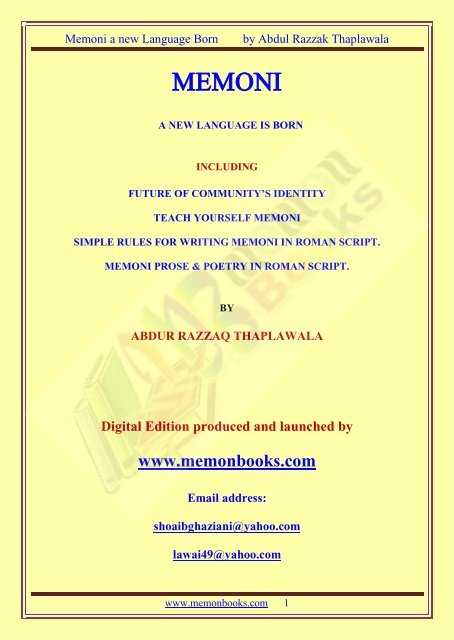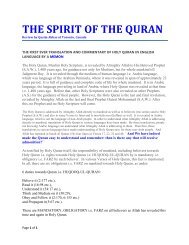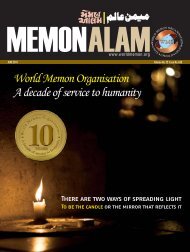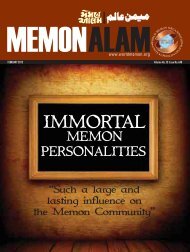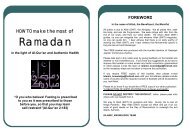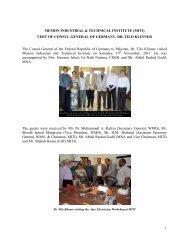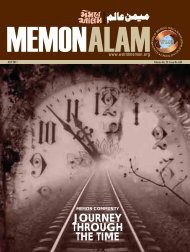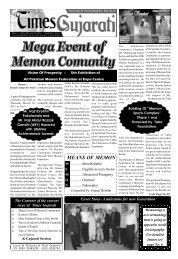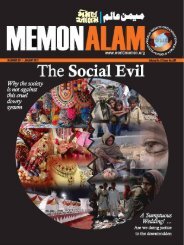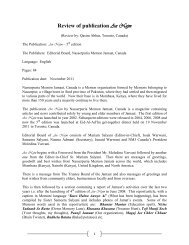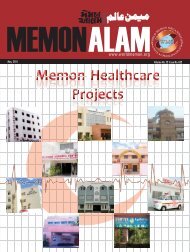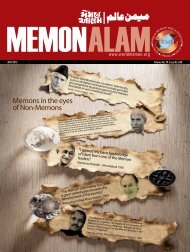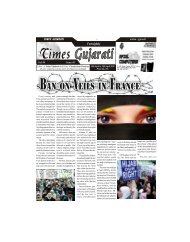Memoni a new Language Born by Abdul Razzak ... - Memon Books
Memoni a new Language Born by Abdul Razzak ... - Memon Books
Memoni a new Language Born by Abdul Razzak ... - Memon Books
- No tags were found...
You also want an ePaper? Increase the reach of your titles
YUMPU automatically turns print PDFs into web optimized ePapers that Google loves.
<strong><strong>Memon</strong>i</strong> a <strong>new</strong> <strong>Language</strong> <strong>Born</strong><strong>by</strong> <strong>Abdul</strong> <strong>Razzak</strong> ThaplawalaMEMONIA NEW LANGUAGE IS BORNINCLUDINGFUTURE OF COMMUNITY’S IDENTITYTEACH YOURSELF MEMONISIMPLE RULES FOR WRITING MEMONI IN ROMAN SCRIPT.MEMONI PROSE & POETRY IN ROMAN SCRIPT.BYABDUR RAZZAQ THAPLAWALADigital Edition produced and launched <strong>by</strong>www.memonbooks.comEmail address:shoaibghaziani@yahoo.comlawai49@yahoo.comwww.memonbooks.com 1
<strong><strong>Memon</strong>i</strong> a <strong>new</strong> <strong>Language</strong> <strong>Born</strong><strong>by</strong> <strong>Abdul</strong> <strong>Razzak</strong> Thaplawalawww.memonbooks.com 2
<strong><strong>Memon</strong>i</strong> a <strong>new</strong> <strong>Language</strong> <strong>Born</strong><strong>by</strong> <strong>Abdul</strong> <strong>Razzak</strong> ThaplawalaAll rights reserves to the AuthorName of Book:Auther:<strong><strong>Memon</strong>i</strong> - A New <strong>Language</strong> is <strong>Born</strong><strong>Abdul</strong> <strong>Razzak</strong> ThaplawalaDigital Edition April 2011Digitalized <strong>by</strong>Qasim Moosa Lawai (www.memonbooks.com)Technical Advisor: Shoaib Ghaziani (www.memonbooks.com)Print Edition: 2005No. of Copies: 1000ISBN No: 969-8606-01-7Price:Website:Freewww.memonbooks.comAny part or whole of the contents of this book can be freelyprinted without permission of the author but without any alteration.The source may please be acknowledged. It will be appreciated if acopy of the publication in which any part of this booklet arereproduced is sent to the author.Compiled and Published <strong>by</strong>Abdur Razzaq ThaplawalaC-15, Dawood Cooperative Housing Society, Karachi-74800Phone: Off: 4534235 Fax: 4534302 Res: 4930229 Mobile: 0300-8223787e-mail: arthaplawala@lucky-cement.comwww.memonbooks.com 3
<strong><strong>Memon</strong>i</strong> a <strong>new</strong> <strong>Language</strong> <strong>Born</strong><strong>by</strong> <strong>Abdul</strong> <strong>Razzak</strong> ThaplawalaAll rights reserves to the AuthorPublications <strong>by</strong> the same auther Mr. Abdur Razzaq ThaplawalaIllegal Occupation of Junagadh - A Pakistani Territory ISBN # 978-969-8935-02-3Bantva Kul Aur Aaj ISBN # 978-969-8935-01-6<strong><strong>Memon</strong>i</strong> – A New <strong>Language</strong> is <strong>Born</strong> ISBN # 969-8606-01-7<strong>Memon</strong> Community & Future of its identity ISBN # 969-8606-00-9<strong>Memon</strong> Community – A Brief Historical Perspective ISBN # 969-8634-00-9The <strong>Memon</strong> Community – ISBN # 969-8935-00-2Its’ origin, history, culture, tradition & languageAny part or whole of the contents of this book can be freelyprinted without permission of the author but without any alteration.The source may please be acknowledged. It will be appreciated if acopy of the publication in which any part of this booklet arereproduced is sent to the author.Compiled and Published <strong>by</strong>Abdur Razzaq ThaplawalaC-15, Dawood Cooperative Housing Society, Karachi-74800Phone: Off: 4534235 Fax: 4534302 Res: 4930229 Mobile: 0300-8223787e-mail: arthaplawala@lucky-cement.comwww.memonbooks.com 4
<strong><strong>Memon</strong>i</strong> a <strong>new</strong> <strong>Language</strong> <strong>Born</strong> <strong>by</strong> <strong>Abdul</strong> <strong>Razzak</strong> ThaplawalaMEMONIA NEW LANGUAGE IS BORNBY ABDUR RAZZAQ THAPLAWALATable of ContentsPREFACE .......................................................................................................................... 6MEMONI LANGUAGE FOR COMMUNITY’S IDENTITY IN FUTURE ................................. 8BRIEF GUIDELINES FOR USE OF .................................................................................. 15ROMAN SCRIPT FOR WRITING “MEMONI” ................................................................... 15MEMONI POETRY ........................................................................................................... 17GUDDEE PUTTAY TE CHADDY VEE .............................................................................. 18BHAA JE GHRE PUTAR AAVIYO .................................................................................... 20SAS JO JANAAZO ........................................................................................................... 22COMPULSORY AAY ........................................................................................................ 23MAASA ............................................................................................................................. 24HEE KERO RIVAJ AAE ?................................................................................................. 25GULISTAN-E-SAADI ........................................................................................................ 26DEKHAVEY JI NAMAZ ..................................................................................................... 26MUSEEBAT ...................................................................................................................... 27POTEY SE KAMTAR KE NARO ....................................................................................... 27RAAZ SEENEY MEY RAKHO .......................................................................................... 27MOUT JEE TAYYARI KARO ............................................................................................ 28BURO NA SOCHO ........................................................................................................... 29ILM NE DOLAT ................................................................................................................ 29HASAD JO ILAAJ ............................................................................................................. 29MEMON BIRADRI NE LEADERSHIP ............................................................................... 30SANJEEDA PAGAL .......................................................................................................... 32ABOUT THE AUTHOR ..................................................................................................... 33www.memonbooks.com 5
<strong><strong>Memon</strong>i</strong> a <strong>new</strong> <strong>Language</strong> <strong>Born</strong>PREFACE<strong>by</strong> <strong>Abdul</strong> <strong>Razzak</strong> Thaplawala<strong>Language</strong> is the only factor of unity as well identification of the<strong>Memon</strong> community in today’s world when almost half of the communityhas migrated from their ancestor oltowns to Pakistan and othercountries. All of them have settled in cosmopolitan cities of Pakistan orin Middle East, Europe or in northern hemisphere.In March, 2001, I had written a detailed article under the caption“<strong>Memon</strong> Community and Future of It’s Identity”. In this article, I hadsuggested that we have to convert <strong><strong>Memon</strong>i</strong> Boli into a full fledgedlanguage and to adopt Roman script for writing it. Quite a few dignitoriesof the community appreciated the idea. To give practical shape to theidea, I requested Mr. Umar A. Rehman, Editor of “<strong>Memon</strong> Alam” Karachito allocate some pages for the <strong><strong>Memon</strong>i</strong> language in the journal. UmerBhai who is always ready to cooperate in every effort for the well-beingof the community readily agreed to the proposal and “<strong>Memon</strong> Alam” isregularly publishing some pages in <strong><strong>Memon</strong>i</strong> language every month foralmost one year. Some other <strong>Memon</strong> Journals and magazines alsopublished some material in <strong><strong>Memon</strong>i</strong> language occasionally in theirjournals.I had expected that <strong>Memon</strong> writers will realize the importance ofthis exercise and come up with articles in <strong><strong>Memon</strong>i</strong> projecting the culture& traditions of the community but unfortunately it did not happen. Itherefore, had to feed “<strong>Memon</strong> Alam” with some material every month.On the occasion of First International Convention of the communityheld at Dubai on 28 th & 29 th April, 2001, I published my article alongwithsome other materials in the form of a 40 pages booklet and arranged itsfree distribution among the participants of the convention.Although the idea of converting <strong><strong>Memon</strong>i</strong> boli into a full-fledgedlanguage was appreciated <strong>by</strong> many, there was very little practicalresponse to my proposal. Since I strongly feel that development of<strong><strong>Memon</strong>i</strong> as a language is essential for maintaining the existance and forwww.memonbooks.com 6
<strong><strong>Memon</strong>i</strong> a <strong>new</strong> <strong>Language</strong> <strong>Born</strong><strong>by</strong> <strong>Abdul</strong> <strong>Razzak</strong> Thaplawalapreserving the identity of the community as a separate ethenic group infuture,I decided to publish another booklet on the occasion of the SecondInternational Convention of the community being held at Dubai on 30 th &31 st March, 2002 to carry the message to the community once again.This booklet is now in your hands. It contains a shorter version of myoriginal article, alongwith guidelines for writing <strong><strong>Memon</strong>i</strong> into RomanScript, some short stories from Gulistan-e-Saadi, some skits in RomanScript previously published in <strong>Memon</strong> Alam, and some <strong><strong>Memon</strong>i</strong> Poemsagain in Roman Script. The short stories from Gulistan-e-Saadi areintended to provide an example of normal <strong>Memon</strong> written in Romanscript. Some of the poems, however do present a glimpse of thelanguage in its original shape i.e. dilect in use in our ancestor villages.The unity and social as well as economic development of thecommunity should be the primary aim of the World <strong>Memon</strong> Organization.The preservation of our culture and language, however is also essentialfor the future identity of the community as a separate group. I hope thatthis small booklet will motivate our writers and journalists to developsome literature in <strong><strong>Memon</strong>i</strong> language about community’s past, its cultureand traditions. I hope that the booklet will be of interest to the leaders ofcommunity as well. I will urge them to place the contents of this bookleton the web sites of their respective organizations so that the members ofthe community in general and the youngsters in particular have accessto it. I will also request them to allocate some space in their communityjournals to the <strong><strong>Memon</strong>i</strong> language.Abdur Razzaq Thaplawala5 th March 2002www.memonbooks.com 7
<strong><strong>Memon</strong>i</strong> a <strong>new</strong> <strong>Language</strong> <strong>Born</strong><strong>by</strong> <strong>Abdul</strong> <strong>Razzak</strong> ThaplawalaMEMONI LANGUAGE FOR COMMUNITY’SIDENTITY IN FUTUREThe <strong>Memon</strong> community is always admired and respected for theirdistinct traits, business acumen, enterprising spirit, honesty, dexterityphilanthropic activities and good mannerism. It has a unique system ofJamats for the welfare of community and for preserving socialrelationship between the members of the Jamats. As long as thecommunity was confined to a certain part of pre-partition India, therewas no problem of its identity. With partition of India a large part ofcommunity migrated to Pakistan where it is no longer confined to smallgeographical areas as in pre-partitioned India but have taken upresidence in large cosmopolitan cities like Karachi and Hyderabad. InIndia the remaining members of the community however still live in theirancestral villages & towns in Katch and Kathiawar.With the increased communication facilities the world has shrunkto the status of a global village. Being part of this global village, thecommunity has also crossed national boundaries and now we can seemembers of our community in almost every part of world. A largenumber of them can be found in Middle East, Africa, U.K. and UnitedState of America. It has now become an international community. Intheir <strong>new</strong> countries of residence, they have been successful inmaintaining their identity as a group and have formed Jamats, Societiesand Associations to provide an opportunity to members of thecommunity for interaction and take collective care of their problems intheir <strong>new</strong> homelands.The <strong>new</strong> homelands of the members of the community are distantfrom their ancestral birthplaces. In <strong>new</strong> homelands, they have theopportunities and compulsions of intermingling with other communities,gradually distancing them from their ancestral traits and qualities. Thisstate of affairs raises an important question. Will the community be ableto maintain its distinct identity in years to come ? With passage of time,fifty years or hundred years after today, the present generation will bereplaced <strong>by</strong> <strong>new</strong> generations which will have little connection with theirwww.memonbooks.com 8
<strong><strong>Memon</strong>i</strong> a <strong>new</strong> <strong>Language</strong> <strong>Born</strong><strong>by</strong> <strong>Abdul</strong> <strong>Razzak</strong> Thaplawalapast. What will be the factors to bind the <strong>new</strong> generation into the fourhundred year old well-knit community?To answer this question, we have to first answer the question as towhat is a community after all? How do we describe it in terms of thepresent day science of SOCIOLOGY? A student of sociology will describea community like that of ours as an ethnic group. According to asociologist, “at a very simple level ethnicity can be thought of as a senseof group identity derived from real or perceived common bonds such aslanguage, race or religion”.“We might view ethnicity as an involuntary state in whichmembers share common socialization practices or culture. There is aconceptual difference between ethnic groups and associations like clubsand society’s membership of which is not involuntary and does notdepend upon common socialization pattern. Ethnic group membership isnot a matter of choice but rather an accident of birth. An ethnic groupconsists of people who conceive of themselves as being of a kind united<strong>by</strong> emotional bonds although they may also share a common heritage” –writes another sociologist.“Ethnicity refers to an involuntary group of people who share thesame culture or descendents of such people who identify them and/oridentified <strong>by</strong> others belonging to the same involuntary group.”It is obvious from the above definitions quoted from well-knownsociologists that we can describe our community as an ethnic group interms of the science of sociology. These definations have described someessential objective characteristics for the existence of an ethnic groupand they include:1. <strong>Language</strong>2. Race – colour – physical features3. Religion4. Geographical location5. Ancestorswww.memonbooks.com 9
<strong><strong>Memon</strong>i</strong> a <strong>new</strong> <strong>Language</strong> <strong>Born</strong><strong>by</strong> <strong>Abdul</strong> <strong>Razzak</strong> ThaplawalaOne of these objective characteristics is essential for continuedexistence and identification of an ethnic group. The religion, ageographical location and common ancestors may be the characteristicsresponsible for initial growth of our community but as we have seen inthe beginning of this article, they are no longer valid as binding force forthe community which is now spread over the entire global village. We dohave a common religion but that is part of a greater Muslim Ummah andwe cannot claim a separate identity <strong>by</strong> virtue of our belonging to Sunnischool of thought. We can not claim overselves as belonging to aparticular race. The colour & physical features of the members of ourcommunity are also not identical.It present times, the only common binding force and the factor ofour identity as a separate ethnic group is our language. You canrecognize a member of our community or establish a connection withanother member of community through speaking in <strong><strong>Memon</strong>i</strong>. Here againit appears desirable to quote from various writings of well-knownsociologists.A well-known sociologist says that if we have to consider therelationship of language and identity, we should clarify our concept oflanguage itself. The distinction between language in its ordinarilyunderstood sense – as a tool of communication – and language as anidentity of groupness, as a symbol, a rallying point is very clear.<strong>Language</strong> can be important in ethnic and nationalist sentiments becauseof its powerful and visible symbolism.“For any speech community in which the language of use is alsothe ancestral language, the intangible symbolic relevance is tied up withthe identity of the ethnic group” – says another sociologist. He continuesand says that“<strong>Language</strong> can be an extremely important feature of identity”.Many sociologists have considered language as an essential pillar forwww.memonbooks.com 10
<strong><strong>Memon</strong>i</strong> a <strong>new</strong> <strong>Language</strong> <strong>Born</strong><strong>by</strong> <strong>Abdul</strong> <strong>Razzak</strong> Thaplawalamaintaining group identity. Even when language has receded to a purelysymbolic role, it can still have an important part in Group Identity.We have seen the importance of language in maintaining &preserving the identity of an ethnic group. If we wish to maintain thepresent distinct identity of our community, we shall have to makeconscious efforts to encourage the members of our community to speak<strong><strong>Memon</strong>i</strong> within their respective homes and outside as well whencommunicating with members of our own community.“<strong><strong>Memon</strong>i</strong>” is not a language in its real sense. It is only a “Boli”without any script of its own. Before partition of the sub-continent, thecommunity was using Gujrati as a mean of internal writtencommunication. This was being done unconsciously and under theinfluence of prevailing atmosphere including the then province of ourdomicile. The level of education within the community was very low andin most cases education upto primary or secondary level with Gujrati asa Medium of Instructions was considered enough. No wonder then thatGujrati became the language of our written communication.With migration of the majority of community to Pakistan, thesituation has changed. In Pakistan Urdu is not only the Nationallanguage of the country but also lingua franca of the entire population.The level of education within the community has also improvedtremendously. The Medium of Instructions is mostly Urdu and in somecases English. There are hardly any Gujrati medium schools in Pakistanand therefore our young generation can neither read nor write in Gujrati.This is not all. In most of our families, specially the educated families,Urdu has been adopted as mean of oral communication within theirhomes as well. A number of our young men and women cannot speak<strong><strong>Memon</strong>i</strong> with fluency. The same should be true for some families in Indiaand most families who have settled outside India and Pakistan. Toattract the <strong>new</strong> generation towards <strong><strong>Memon</strong>i</strong>, we have to cultivate thehabit of speaking <strong><strong>Memon</strong>i</strong> at homes.www.memonbooks.com 11
<strong><strong>Memon</strong>i</strong> a <strong>new</strong> <strong>Language</strong> <strong>Born</strong><strong>by</strong> <strong>Abdul</strong> <strong>Razzak</strong> ThaplawalaBut this is not enough. We have to build interest of <strong>new</strong> generationinto <strong><strong>Memon</strong>i</strong>. They should feel proud that they have a language of theirown and this feeling of pride can only arise if they know <strong><strong>Memon</strong>i</strong> as fullfledgedlanguage and not a Boli.To preserve our identity as a distinct community, we shouldexplore the possibilities of converting this “<strong><strong>Memon</strong>i</strong> Boli” into a “<strong><strong>Memon</strong>i</strong><strong>Language</strong>”. We all know that use of Punjabi and Pushtoo as writtenlanguage is a matter of not very distant past. In Pakistan, Punjabi iswritten in Urdu script and India it is written in Devenagri script. TheSaraiki and Hindko speaking people in Pakistan have started to makeefforts to preserve their identity <strong>by</strong> turning their dialect/Boli into writtenlanguages only recently. If it is so why cannot we do the same? Bymaking this proposal I am not trying to encourage any linguisticprejudice. I honestly feel that this will be an effort towards nationalintegration of our community within Pakistan.For quite sometime, I have been thinking over the matter of thescript most suitable for the community. Our community is now locatednot only in Pakistan and India but also in Africa, Middle East, U.K.,U.S.A. and Canada. Why can’t we think about adoption of Roman scriptfor <strong><strong>Memon</strong>i</strong> instead of Urdu, Gujrati or Sindhi script? Is it not a fact thatthe whole of Europe is using Roman script with minor variation for theirrespective languages? Turkey did it in only in the recent past. Indonesiaand Malaysia have also adopted Roman script for their languages. If weadopt Roman script for <strong><strong>Memon</strong>i</strong>, it will be equally readable <strong>by</strong> <strong>Memon</strong>sliving anywhere in the world whether Pakistan, India or even in Europe,USA or Canada.In this age of computer, the Roman Script is easy and convenientfor writing and communicating. You can easily type it on any ordinarytypewriter or computer. You can even send an e-mail in <strong><strong>Memon</strong>i</strong> to yourrelatives, friends and business associates. One hears a lot about thecomputerization of Urdu’s “Nastaliq” script. However, it still takes a greatdeal of time to type Urdu. Computerized Urdu composing requires aformidable keyboard with too many letters. Vowels constitute anotherwww.memonbooks.com 12
<strong><strong>Memon</strong>i</strong> a <strong>new</strong> <strong>Language</strong> <strong>Born</strong><strong>by</strong> <strong>Abdul</strong> <strong>Razzak</strong> Thaplawalaordeal for the typist or computer operator who finds Urdu five timesslower than English. For using Roman Script to write <strong><strong>Memon</strong>i</strong>, we mayform some simple rules assigning specific phonetic sounds to alphabets,which have more than one phonetic sound. Some suggestions areincluded in this booklet.It is essential that we maintain our identity and rather strengthenit. For this purpose, we must keep emphasizing the need of developing“<strong><strong>Memon</strong>i</strong>” into a language. At the book launching ceremony of Mr. IqbalMotlani’s “Panji Boli Main” the first book in <strong><strong>Memon</strong>i</strong> in urdu script, I hadquoted an extract from a report of a seminar on “<strong>Language</strong> loss andPublic Policy” held at University of Mexico recently. The same is beingreproduced below:<strong>Language</strong> is one of the corner stones of any culture. It cementsthe unique identity of a group, expresses the particular concerns, andneeds of that group. For Indigenous peoples the threat to their culturespresented <strong>by</strong> the intrusion of outside influences may be a majorcontributing factor to their loss of identity. Loss of language underminessocial structures and aids the disappearance of group culture, especiallywhere this is dependent on an oral history and tradition.What do we need to do to achieve our objective?1. We should realize that with the passage of time, we shouldface a crisis of identity.2. <strong>Language</strong> is the only source of identification of members ofour community and we should work to preserve and convert “<strong><strong>Memon</strong>i</strong>”into a full-fledged language.3. We should encourage the oral & written communication in<strong><strong>Memon</strong>i</strong> in all inter-personal contacts between the members ofcommunity.www.memonbooks.com 13
<strong><strong>Memon</strong>i</strong> a <strong>new</strong> <strong>Language</strong> <strong>Born</strong><strong>by</strong> <strong>Abdul</strong> <strong>Razzak</strong> Thaplawala4. If possible, we should start publishing a weekly or monthlyjournal in “<strong><strong>Memon</strong>i</strong>” and ensure its wider circulation. If this is notpossible the existing journals and magazines of various communityoranizations should reserve some pages for articles and <strong>new</strong>s in <strong><strong>Memon</strong>i</strong>in Roman Script.5. All Jamats and associations of the community should startissuing circulars and notices of meetings etc in <strong><strong>Memon</strong>i</strong> in Roman Script.6. All <strong>Memon</strong> organizations should place this article and othermaterial available in this booklet on their web sites.It is not an easy task. Development of a language takes time butwith determined and coordinated efforts, it can be done. It is possiblethat many of us may not see the development of <strong><strong>Memon</strong>i</strong> into a fullfledged language in their life time but they should contribute whateverthey can, for this noble cause.Let us conclude <strong>by</strong> repeating that we are known as a reputablecommunity of businessman and philanthropist for last three hundredyears. But how long will we be able to maintain this distinct identity?With partition of India we no longer live in Kathiawar or Katch. Thecommunity is now spread all over the world. The geographical locationhas not remained a factor of our identification as a separate community.The only common factor to bind the members of our community into adistinct ethnic group is our language.PRESENTLY, WE MAY NOT BE FACING A CRISIS OF IDENTITY BUTTHINK OF NEXT FIFTY OR HUNDRED YEARS. IN YEARS TO COME, WEMAY LOOSE OUR IDENTITY AS A SEPARATE GROUP UNLESS WE DOSOMETHING TO DEVELOP “MEMONI” – THE ONLY BINDING FORCEBETWEEN US INTO A FULL FLEDGED LANGUAGE.www.memonbooks.com 14
<strong><strong>Memon</strong>i</strong> a <strong>new</strong> <strong>Language</strong> <strong>Born</strong><strong>by</strong> <strong>Abdul</strong> <strong>Razzak</strong> ThaplawalaBRIEF GUIDELINES FOR USE OFROMAN SCRIPT FOR WRITING “MEMONI”Roman script is known to us as it is used in English language. Weall know that the alphabets of the English language produce differentphonetic sounds when used in different words. This applies mainly tovowels, which are A, E, I, O and U. The compilers of English dictionariesuse certain marks on these vowels to indicate their phonetic sounds inbracket after most of the words to convey the correct pronunciation ofcertain words in the dictionary. The following examples of differentphonetic sounds of vowels will make the things clear:A = Fat I = Bid U = Mute= Advice = Private = Run= Father = Import = Put= Army = BirdE = Me O = Open= Bed = Money= Elect = MouseThe rest of the alphabets are called consonants. In consonants, thephonetic sounds differ only in a few cases. For example :-C = Cat N = Nine= Centre = KingG = Game S = Ship= Ginning = StationIn writing <strong><strong>Memon</strong>i</strong>, we are not creating a <strong>new</strong> language. We areonly trying to put a widely spoken “Boli” into black & white. It should notbe difficult for a person familiar with spoken “<strong><strong>Memon</strong>i</strong>” to understand itwww.memonbooks.com 15
<strong><strong>Memon</strong>i</strong> a <strong>new</strong> <strong>Language</strong> <strong>Born</strong><strong>by</strong> <strong>Abdul</strong> <strong>Razzak</strong> Thaplawalawhen reading in a script known to him. It should be assumed that areader or writer of <strong><strong>Memon</strong>i</strong> is well familiar with spoken <strong><strong>Memon</strong>i</strong> and hasthe ability to read English language. The ability to write English languagewill make his task of writing <strong><strong>Memon</strong>i</strong> easier. There may be some initialdifficulties but those will be overcome with practice and passage of time.However, we can decide that we will use the following alphabetspreferably for sounds given below :-A = Will be used for its sound in FATHER and we will use E forits sound in FAT. We may use “AA” for sound of “A” inARMY.E = Will be used for its sound in ‘BED’ and not for its sound in‘ME. For sound in “ME”, we will use double E i.e. MEE.U = Will be used for its sound in “BUT” and not for its sound inPUT. For the sound of ‘U’ in “PUT”, we will use “OO”.C = Will be used for its sound in “Circle” or “City” and not“Cat”. For sound of C in “CAT”, we will use ‘K’.G = Will be used for its sound in “Game” and not for sound in“Ginning”. For sound of ‘G’ in “GINNING”, we will use ‘J’.S = Will be used for its sound in “Ship” and not for its sound in“Station”.N = The alphabet ‘N’ in its capital form in the beginning of a wordor in small form within a word will be used for its sound in‘Name”.In every language, a nasal sound is used for pronunciation ofcertain words. In urdu, it is called “Nun Gunna”. In Gujrati it is called“Mindi“ and is represented <strong>by</strong> a dot on the alphabet. In Roman Script ‘N’produces a nasal sound in many words but no specific indication iswww.memonbooks.com 16
<strong><strong>Memon</strong>i</strong> a <strong>new</strong> <strong>Language</strong> <strong>Born</strong><strong>by</strong> <strong>Abdul</strong> <strong>Razzak</strong> Thaplawalaavailable. For example in the word “Cement” you do not pronounce ‘N’as in “Name”. The sound of ‘n’ in “Cement” in a nasal sound. For<strong><strong>Memon</strong>i</strong>, it is proposed that whenever we intend to have a ‘Nasal’ soundin a word we use ‘N’ in capital. Some examples are:<strong><strong>Memon</strong>i</strong> WordEnglish TranslationMeiN = InaaeN = YoupaaNjay = OurasaaN = WeEnglish Word = When an English word isused, its normal Englishspelling will be adopted.These are simple and easy guidelines, which we may use withpreference. We can always alter them whenever it suits us for the sakeof fluency.There is slight difference in dialects of spoken <strong><strong>Memon</strong>i</strong> used <strong>by</strong><strong>Memon</strong>s of different areas. For example, a <strong>Memon</strong> from Bantva may usea word different from a Halari OR Katchi <strong>Memon</strong>. There is nothing unusualabout it. We know that even in case of Urdu, we come acrossdifferences in dialect of Luckhnow, Delhi and Bihar. With practice andpassage of time, we will become used to it.MEMONI POETRYWe have quite a few good poets who compose poems in “<strong><strong>Memon</strong>i</strong>”.Such poems are printed in Gujrati script and are published in Gujraticommunity journals like “<strong>Memon</strong> Alam” and “<strong>Memon</strong> Welfare” etc. If youdo not know Gujrati or do not have access to these journals, you cannotenjoy these poems. Here is an opportunity for you to read and enjoythese poems in Roman Script.The name of the poets and the source is acknowledged with eachpoem.www.memonbooks.com 17
<strong><strong>Memon</strong>i</strong> a <strong>new</strong> <strong>Language</strong> <strong>Born</strong> <strong>by</strong> <strong>Abdul</strong> <strong>Razzak</strong> ThaplawalaGUDDEE PUTTAY TE CHADDY VEEBy Munshi DhorajviDubai meiN <strong>Memon</strong> jee parisad bharai veePuttay te chaddi vee, guddee pattay te chadhy veeAapas meiN ghaal bol ne mulakat bhi thee veePuttay te chaddi vee, guddee pattay te chadhy veeAllah lamee hayaat diye razak kay<strong>Memon</strong> ghandhi naam kay – inyejee shaakh kayHinye jee mehnat jaa miran <strong>Memon</strong> kay fulAye qaum! hakde netaa jee to aangri zhalEhsan rub jo aae kammittee bhi baneeveePuttay te chaddi vee, guddee pattay te chadhy veePay dada paNke dee viya khidmat jo wirsoPaN dil meiN keen gini achoo saitani waswasoBus aikta jo khiyal kuro, nay kamar kasoQoum ke disso – lakkhan naa disso aib naa dissoSadko aay buzergaN jo kay manzil ta miriveePuttay te chaddi vee, guddee pattay te chadhy veeHaji Razak Tasty karyaa aeen dor-bhaagDoraayaa sakrani nay fancy dimagNasir Fulara, Noorani, Moti nay Adam NoorDuniya jay <strong>Memon</strong> kay deena aikta ja soorLondon meiN SECRETARIAT jee yojna thee veePuttay te chaddi vee, guddee pattay te chadhy veeGirya een committee meiN harek mulk jaa memberHaji Razak Ghandi baniya qoum jaa rehberHinye jay waasay haloon, khoob kum karooNHer mulk meiN mazboot karoon qoum jee jarooNDubai jee parisad say hee dorvanee miree veePuttay te chaddi vee, guddee pattay te chadhy veewww.memonbooks.com 18
<strong><strong>Memon</strong>i</strong> a <strong>new</strong> <strong>Language</strong> <strong>Born</strong><strong>by</strong> <strong>Abdul</strong> <strong>Razzak</strong> ThaplawalaHaji Latif Jamal nay Haji AbubakarBhivandee warry Haji Suleman jo zikerKin kin ja naam yaad rakhan aoon, kin kay paaN bhulloNHinye jay pagle pagle hane paN halooNDubai jee parisad asal maqsad te pugee veePuttay te chaddi vee, guddee pattay te chadhy veeNOTE: Capital ‘N’ in the mid or at the end of a word represents Nasalsound of ‘N’(Roman Script: ART)www.memonbooks.com 19
<strong><strong>Memon</strong>i</strong> a <strong>new</strong> <strong>Language</strong> <strong>Born</strong> <strong>by</strong> <strong>Abdul</strong> <strong>Razzak</strong> ThaplawalaBHAA JE GHRE PUTAR AAVIYOBy Mr. Iqbal Peer Kasid DhorajviBhaa je ghre putar aaviyoHee taar se janyooNMaa jee duaa thee allah raaji thiyoBhabhi jo khoro bharanuKharcho bhale thee viyoGigay jo sattar nalo rakhaanuKharche jo hisab karyasiKharchan poora charso banuSattar hane sut whar jo thiyoWiri sunnat jo Aviyo tanuUdhar uchina gini neChah ne khaajioon banyunChatti thee vee, sunnat thee veeHave natre jo pawan felanuMubarak bhaa mubarakSattar je natre jo chah piwaniuHalo badhe laahua ginuWari kade naarinasu tanrooChaar man sukkar aaviSavaso narial aaviyaHinsi ochi oy lahnTaN panji aabroo meiN poy paahrooNWaariyooN, earing ne patti gharaniNe choodo bhi ghranooMaheeno thee viyo natrePachi jinsunNchadayunJinsuN gini badhi wiyasiShaame bheri thiyoon wiyaaruNPaaNtri so jo hisaab kari neWhiyaaN jo dhol mandanuBoso bhale wadhare kharchinPaN mehfil akri karayooNwww.memonbooks.com 20
<strong><strong>Memon</strong>i</strong> a <strong>new</strong> <strong>Language</strong> <strong>Born</strong><strong>by</strong> <strong>Abdul</strong> <strong>Razzak</strong> ThaplawalaChaar hajaar jo dhuanu kariKholyasi jamat khanooNooh aavi, kutumb raji thiyoAllah deeni aay tarooN(MEMON WELFARE JE SHUKRIYA JE SAATH)(ROMAN SCRIPT ART)www.memonbooks.com 21
<strong><strong>Memon</strong>i</strong> a <strong>new</strong> <strong>Language</strong> <strong>Born</strong>SAS JO JANAAZO<strong>by</strong> <strong>Abdul</strong> <strong>Razzak</strong> ThaplawalaBy Mr. Iqbal Peer Kasid DhorajviKalma darod parhja, kalma-e-shahadat parhjaMiNjee sas jo janaazo aae, zara dheere se haljaaPaNji wakt jee namaaz, ne ibadat jaa paabaNdDil gurde jaa wadaa, ne sadaaqat jaa paabaNdBacheN ke karan piyar, ne mohabbat jaa paabaNdKalma darood parhja, kalma-e-shahadat parhjaMiNjee sas jo janaazo aae, zara dheere se haljaaRaat dhiN miNje laae duayooN bhalai jee karanBachen ke miNjhe jhoole mein soomari jhoolayaa karan“Hut gulura bhagee win” jee loree sonaayaa karanKhidmat jo moko naa miriyo, hane mike koi zaljaMiNjee sas jo janaazo aae, jara dheere se haljaaDeraani, jethaani mathe hooee enye jee hakree nazarHee sas waa, ke ma waa, ke pey, na koee ke khabarSas, ma, jo rutbo hakro, hane pee asaaN ke khabarJannatul firdous mein darjo ucho mire, dua aeri karjaMiNjee sas jo janaazo aae, zara dheere se haljaaDil jee akhian ke aaeN sadaa ughari rakhyaanooh, dhee, ke sadaa brabar rakhyazaeefi je aalam meiN mehnat mushakkat se naa thakyaaKhushbu jo bagecho ne jhaar aaeen fulful jaaMiNjee sas jo janaazo aae, zara dheere se haljaaBoy kandhe te upaari janaazo, wineta aaynja putarHalee vee pay jee outh, ne hanre halivee man jee chahatPay jee dooayeN see, ayun asaaN aj buland tarRaat deeNh duaa karja, ne sabre jamee maNgjaMiNjee sas jo janaazo aae, zara dheere se haljaa(<strong>Memon</strong> Welfare – Mumbai – Ed Edition Jay Shukriya Je Saath) (Roman Script : Art)www.memonbooks.com 22
<strong><strong>Memon</strong>i</strong> a <strong>new</strong> <strong>Language</strong> <strong>Born</strong> <strong>by</strong> <strong>Abdul</strong> <strong>Razzak</strong> ThaplawalaCOMPULSORY AAYBy Shakir VartejeeMohabbat jaa bo ghooNt compulsory aayBufay hoy taaN loot compulsory aayWigar boot jo hitay wehna badhey paNBhalay gate tay boot compulsory aayBhalay khen Ramzan jaa pura RozaPar iftar meiN fruit compulsory aayKaray lambe takreer leader koee joTa hun jalsay meiN hoot compulsory aayGhanaa RAT khaade pachi, minee boliBadalnoo hane Rout compulsory aayDisee prem, sus nuh jo, hedo lagetoKade kade fruit compulsory aayBhalay aay “Shakir” saras Ghar ministerJeewan meiN kada kut compulsory aay(Roman Script: ART)www.memonbooks.com 23
<strong><strong>Memon</strong>i</strong> a <strong>new</strong> <strong>Language</strong> <strong>Born</strong> <strong>by</strong> <strong>Abdul</strong> <strong>Razzak</strong> ThaplawalaMAASABy Yunus KaisHur jaghaa tey hitraa untaa Maasa!Nandhaa, waddaa, tamaam chuntaa Maasa!Aj paNsay dawat meiN pugaay nhee!PaN, sabhayan say pehla huNtaa Maasa!Botiyoon Na miran taa chutkay kamaan!Jump maari deg meiN pooNta Maasa!Deen jee ghaal acheta, jaan vinay tee!Dhandaj kidaa aaen ? Roonta Maasa!Masee watay hameshaa “Chup Shah” jo rojo!PaNkay piNja palaakha puchanta Maasa!Masee kay A.C. see ALERGY aay!Office meiN hitray sumanta Maasa!Cvp rhen taa, janay he lageto!“Loban Shah” tay jaany doran taa, Maasa!Bolo PaN jiraa zor say bolo!Sunnee, sunnee, suranta, Maasa!Bus, jara isaaro neyaz jo diyo!Puchnaa puchnaa, puganta Maasa!RaNgeen yaadeN meiN dubi viyaa!Khulne, khulne, khulantaa, MaasaMaasay, kay Maama banayNooVahee nay hamaisha, soomantaa Maasa(Roman Script: ART)www.memonbooks.com 24
<strong><strong>Memon</strong>i</strong> a <strong>new</strong> <strong>Language</strong> <strong>Born</strong> <strong>by</strong> <strong>Abdul</strong> <strong>Razzak</strong> ThaplawalaHEE KERO RIVAJ AAE ?By Haji Bha – Muhammad HussainHee kero rivaj aae ne keri reet aae ?Hee kero riyaz aae ne hee kero geet aae?Fakat hakri khombhi main khapeti asan ke bahu raniJahez nari ne tanreji bhook tade koi-ke na desaniJahez parosi jee noohn jo nari ne badhe ji akh traniGareeb jee dhee foolrani have badhe ke norkani disaniHee kero rivaj aaeHee keri reet aae ?Ahkame azmat potenji bhuli ne baai share aaveeTouko duptto, khule mathe, dhani ke kaboo karajoSikhi ne aaveeHakro suni, char sunainjee hidayat gini ne bai aaveeBolya dosa “jirak sharam rakho” suni bai mavtre bhagi aaveeHee kero rivaj aaeHee keri reet aae ?(Roman Script : ART)www.memonbooks.com 25
<strong><strong>Memon</strong>i</strong> a <strong>new</strong> <strong>Language</strong> <strong>Born</strong>GULISTAN-E-SAADI<strong>by</strong> <strong>Abdul</strong> <strong>Razzak</strong> ThaplawalaPRESENTLY, WE MAY NOT BE FACING A CRISIS OF IDENTITY BUTTHINK OF NEXT FIFTY OR HUNDRED YEARS. IN YEARS TO COME, WEMAY LOOSE OUR IDENTITY AS A SEPARATE GROUP UNLESS WE DOSOMETHING TO DEVELOP “MEMONI” – THE ONLY BINDING FORCEBETWEEN US INTO A FULL FLEDGED LANGUAGE.Shaikh Saadi Shirazi (1175-1291 AD) was a famous Persian poet –His two books “Gulistan-e-Saadi” and “Bostan-e-Saadi” are very famousfor short stories based on wisdom of everyday life.Some short stories from Shaikh Saadi’s “Gulistan-e-Saadi” in<strong><strong>Memon</strong>i</strong> language and Roman Script previously published in “<strong>Memon</strong>Alam” Karachi are reproduced in the following pages alongwith somehumourous skits. These stories are intended to provide specimen of“<strong><strong>Memon</strong>i</strong>” in Roman Script.MEMNI ZABAN MAINDEKHAVEY JI NAMAZAkre neik maru ke akro Badsha khain ji dawat dini. Jadhey badheykhain lae vetha ta hu maru bahuj cum khadi ne namaz lae hali viyo. Heemamool se vadee namaz pari ta ke badhey hunkey kam-khuraq ne bahujneik samjhan. Jadhey hu pote je gharey viyo ta hu poteji chokrey vatethee khain lae mangi. Hu pote je chokrey ke chue ke aau hin-lae kumkhadoom ke badhey samjhan ke aau kum khiya toe. Ta hu chokro poteje Walid ke chue ke namaz bhi wapis parhi gino kulae ke aane Namazbhee logen ke dekharen lae pariya wa.SABAQ:Dikhavey jee namaz bhee zaya thee veneti.www.memonbooks.com 26
<strong><strong>Memon</strong>i</strong> a <strong>new</strong> <strong>Language</strong> <strong>Born</strong>MUSEEBAT<strong>by</strong> <strong>Abdul</strong> <strong>Razzak</strong> ThaplawalaAkro Chowkidar akre Chor ke pakri gini ne rassi se bandhi nezameen te sumari dini. Chor pareshani ne takleef se sajhi raat na sumisighyo. Hunke mehsoos theo ke koi shakhs pote ji pareshani ji wajha serooi rhio aae he aawaz wate theej achi rhee we. Chor unji roonji awaazsuni nea chuee ke to kade tak rune ? Haren aaram se sumi vin.Toke taAllah jo shukar ada karnu khape ke to Chowkidar tokey rassiyan se nebandhi. Matlab hee aae ke har shakhs ke pote ji taklif wadhare lageytee. Jadhey pote se bhi wada dukhi ne pareshan hin dunya mein mojoodheen panje sabar kario khape. Chor hun maroo ke chui ke toje roon semike takleef theye tee. Chup thee vin.SABAQ: Har shakhs kay pote ji museebat vadi dekhae tee.Halanke biyenji museebat nari ne pote ji museebat ke bhuli vinnukhappay.POTEY SE KAMTAR KE NAROAkro thakelo musafir ruee ruee ne chuee riyo vo ke hin jungle meymijhey se vaddo miskeen ne lachaar koi ne. Kulai ke meejey watey koeesawari neh – Aaon pedal hali hali ne thaki vio yaan. Wazan mey dabeloakro ghadhero jadey hee ghaal sunee ta hun musafir key chuee kebatameez aasmaan jey zulam se roey-to. Tokey taa Allah jo shukarkarnu khapay ke tokey sawari lae ghaddho ney milyo lekin ghaddho bhine banayo jintey koi sawaar bhi thee sighey.SABAQ: Potey see kamtar halat warey ke nari ney Allah joshukar ada karnu khapay ke hu paan key hun jhero neh kari.RAAZ SEENEY MEY RAKHOAkro Turk Badsha jinjo naam Taqsh vo hu potey je akhre ghulamkey akri raaz ji ghal batari ne nasihat kari ke hee ghall agya koeake nawww.memonbooks.com 27
<strong><strong>Memon</strong>i</strong> a <strong>new</strong> <strong>Language</strong> <strong>Born</strong><strong>by</strong> <strong>Abdul</strong> <strong>Razzak</strong> Thaplawalachoy. Hee raaz akrey saal taq to raaz riyo lekin hinjey baad achanakzahir thee viyo. Badsha jallaad ke hukum dini ke jo log raaz ke afshaakarya heen badhey je gerdan udae chado. Akro Wazir Badsha jeekhidmat main araz kari ke “badshah Salamat badhey ghulam be-qasoorheen kure lae ke wado gunah ta Badshah Salamat khud karya een kehoo poten jo raaz akre Ghulam ke batari dinaw.SABAQ: Agar aany koi raaz ke mehfooz rakhnu chahyo ta poteyjay raazdar ke bhi raaz na bataro balkey hun raaz kay potey jay seeneymein dafan kari diyo.MOUT JEE TAYYARI KAROAkro Maru mari viyo ta biyo maru hunjey gam mey potey jogrebaan phari vijhee. Akro samajdaar maru hunjee hin harkat ke nari nechuee ke agar murdey ja hat harkat karna wa ta hu tojey zulam se poteyjo kafan phari gini vee ne tokey chuee vee ke tu mijhee mot se itrogusso ko khae to. Aau agar akre deen pehla achee viyoe ta too akreydeeh baadmey achney. Mijhi mot te ta tu roe to magar poteji mot kebhuli vine to Kaal toje saath hij theeno.Saheb-e-baseerat maru jadheymurdey te mittee ujhanta ta u ee sochee ne roon to ke kaal mijheymathey bhi biya mitti ujhna.Agar akro nandho bacho mari uney to taunjo gam me kure lae roe to ke hun jero masoom dunya me aavio vo nemasoom hali viyo. Fikar jhee ghaal ta hee aae ke too pak achi ne napakna unno varna Allah Taala wate wadi sharmindigi theeni. Rooh jeparindey ke aamal jo paband kari gino varna hee udee viyo koee kebhee na thee signo.SABAQ: Jadhey too koiji Namaz-e-Janaza parhe ta hee sochigin kay akrey deen toji bhi Namaz-e-Janaza parhaini. Jadhey koi keydafnayo ta hi sochi gino ke akre deen paankey bhi heenj dafnaina.Marele mathey roon je bajaae potey jee mout ji tayari karo.www.memonbooks.com 28
<strong><strong>Memon</strong>i</strong> a <strong>new</strong> <strong>Language</strong> <strong>Born</strong>BURO NA SOCHO<strong>by</strong> <strong>Abdul</strong> <strong>Razzak</strong> ThaplawalaAkre Badsha jo ghulam bhagi vio. Badsha ja maru hunkepakri ne badhsha je samne paish karya. Wazir ke hun ghulam sedushmani vee. Hu Badhsha ke mashvaro dini ke Badsha salamat hinkeqatal kari diyo. Ghulam araz kari ke Badsha salamat aenje samne mijhigardan hazir aae lekin aaun namak-khuar yan ne aaun natho chahya keqayamat jay deen aenje mathe mijhey qatal jo ilzaam lagey. Agar aaenijazat diyo ta aaun hin wazir ke qatal kari diya baad mey aaen mikeyqatal karai dija. Hin soorat me mijho qatal jaiz huno. Badhsha khiliyo <strong>new</strong>azir ke chui ke toji kuro raae aae. Wazir chui ke Badsha salamat mijhimunasib rae hi aae ke khuda je lae hin ghulam ke azad kari diyo ta-ke himikey koi museebat me na phasai dye.ILM NE DOLATMisr me bo bhaa rehna wa. Akro bhaa taaleem hasil kari ne akrobhaa rupya jama kari. Natijo hee theiyo ke paran varo ta Allama baniviyo ne rupya jama karan varo Shahi Khazanchi bani viyo.Akri dafa dolatmand bha pote je Aalim bha ke hakakrat ji nazar senari ne chui ke naar aaon ta khazane jo malik bani viyoe ne too muflisthee viye. Aalim bha chui ke aaon ta hin haal me bhee khuda jo shukarada karan to ke hu mikey Pegambaran jee Meeraas (ilm) ata kari aaemagar aaen ke Firon je virasat (yani Misr jee Hukumat) mein kam miriyoaaye.HASAD JO ILAAJHakro Sipahee jo bha bahooj vado zaheen , badmaash ne chalaaqvo, bachpan hi se vadpan ja asaar hunjee paishaani te zahir wa. Badshane hunjee gair mamulee zahanat je bare me sunee ta hunke pote jedarbar me barki. Biya darbari hun se hasad karan lagya.ne badsha jeewww.memonbooks.com 29
<strong><strong>Memon</strong>i</strong> a <strong>new</strong> <strong>Language</strong> <strong>Born</strong><strong>by</strong> <strong>Abdul</strong> <strong>Razzak</strong> Thaplawalanazar me hun ke charain lae hun mathey khayanat ja ilzaam lagaya lekinjadhey dost meharbaan hoe ta dushman kee bhee natho bigari sighey.Badshah hun ke puchee ke hee maru to se kure lae naraaz aaen.Hu jawan chuee ke Jahan panha jadhe se hee ghulam aaenji panha meavyo aae har shaksh ke aaun raazi kari ginyo aayan lekin haasid jo aaunkuro karan hu ta heenj bari riya aaen ne unan ke khushee jadhej theesighe tee ke aaen mike zaleel kari ne nikari vijho. Aaon chahya toe kekoi ji dil azaari na karaan lekin hee haasid jo barnu hairo aae ke hinjeetakleef se sirf moteej nijaat derai sighan ta.MEMON BIRADRI NE LEADERSHIPPanji Biradri jee hee badkismati aae ke pan wate koe akro Leadernaae. Hin jo kuro karan aae ? Hee sawal jo jawab bahoo mushkil aae.Shayad panji biradri jee hee fitrat aae ke pan koi akre fard ke Leaderbanan lae tayyar nee yhoon. Panji biradri jo har sakhs hee samjhey toke paan badhe barabar yun ne koi bhee biae sakhs si bartar naae. IqbalMotlani Saheb jee Kitab “Panjee Boli Mein” main akri bahooj dilchasphikayat aae. Jara hin hikayat mathe socho ne wichar karo.Akre Raja jee riyasat mey akro ahro gaam wo jin-mein <strong>Memon</strong>biradari jee aksariyat vee. Raja faislo kari ke uun gaam jo patel kok<strong>Memon</strong> ke banainu khapay, ta key uu pooray gaam jee theek theekaagiwani kari sigey. Raja Wazir key hukum dini – ke hin gaam jey wadeywadey <strong>Memon</strong> vepari, ne khas khas marwain key daawat di ne Mehalmein barkayan mein acche ne akri raat Mahal mein rakhi ne beeyedheen Raja thee mulakat karain mein ache. Mehmaanan ke Mehal meyraat guzaran laey akro wado kamro deen mey aviyo. <strong>Memon</strong> Bhakamrey mey pugya, tao hi nari ney hairan thi wiya ke kamrey je wichmey khali akro manjo (Charpai) aae, ne baqi pathariyu zameen te vichanme aviyu aeen. Ee to ghamgheer samsiya thee vee … Ghaffar Bhamathey suman to Shakoor Bha neeche keen suman? Sattar Bha keymanjo deen mey achey, to Qasoo Bha key Kharab lagno …..; Paan meyto badhey Haji ne Moazez aeen … harean panjo theeno kuro … ?www.memonbooks.com 30
<strong><strong>Memon</strong>i</strong> a <strong>new</strong> <strong>Language</strong> <strong>Born</strong><strong>by</strong> <strong>Abdul</strong> <strong>Razzak</strong> ThaplawalaAdh raat sudhi soch vichar kari ne <strong>Memon</strong> bha akrey faisly teypugya key hin manjhey mathey koi akrey jo haq naey – aitry paanbadhai zameen tey ahrey tareeqey sey sumi vinjey ke badhey jaa pugmanjhey mathey hoon ta key badhey jo maan rai viney.Sawaar jo Wazir achi ney nari to chakrai viyo ke hee kuro …?Manjhey mathey koi nae sutto balkey Manjhey mathey pag rakhan jikoshish mey badhai bey araami ji nindhar sutta aaen.Mehmanan ke jagaan je badley, Wazir Rja wattey vini ney haqiqatbatari – etrey Raja panji biradari ke mulaqat kare vigar pacho mokli dini.Pachee hin gaam jey Hindu banye ke barkan mey aviyo. Wazirunan jey saath bhi heej sulook kari, ne sawar mey vini ne nari to badhaiaraam se zameen tey sutta va, ne akro, waddi umer jo maru manjhey jemathey araam kari reo vo.Wazir samjhi viyo ke Manjhey mathey jo maro sutto aae hin keybaqi badhai Leader tariqey kabool kari ginya aaen. Wazir Raja ke khabarkari dini, ne Badhsha mehmanan si mulaqat kari ne unye jey Leader kegaam jo Patel banai dini – jadhey ke hun gaam mey aksariyat <strong>Memon</strong>biradari ji vee.(Iqbal Motlani jee kitab Panji Boli jay shukaria jay saath)HIN KAHANI SEE KURO MATLAB NIKRE TO ? PANJI BIRADRI KEHIN MATHE VICHAR KARIO KHAPE.www.memonbooks.com 31
<strong><strong>Memon</strong>i</strong> a <strong>new</strong> <strong>Language</strong> <strong>Born</strong>SANJEEDA PAGAL<strong>by</strong> <strong>Abdul</strong> <strong>Razzak</strong> ThaplawalaPagal Khaney jo Doctor navey mareezey ke nari riyo vo. Akropagal un-key sidho nazar avo. Doctor un-key puchee ke to-ke ida kurelae gini awya heen. Tu ta theek Lagen To.Pagal jawab dini , “Janab aau bilkul theek yaan, dar asal thio heeke aaun akri bairee se shadee karum jin jee akri 18 saal jee chokri bhivee. itefaaq se hu chokri mijhey bapa key pasand achi vee ne hu un-senikah kari gini. hun deen se mijhee bairee mejhey bapa jee sus banivee. Thorey arsey baad mijhee bapa jeee bairee key bacho peada theyo.Hee bacho rishtey je lehaz se mijoo bha theo, kulae-ke uo mijhee bapajo chokro Wo. Magar udda mijhee bairee jo navaso bhi theo. Yaneekey aaun pote jey bha jo nana bani viyoe. Thore arsey je baad mijheygharey bhi bacho paida theo. Hun deen se mijhey bapa ji bairee mijhesoteley bha jee bhain thee vee magar hu hunjee dadi bhi thee veekurey-lai-ke hun jo gharwaroo yanee mijho bapa mijhe putar ja dadatheen hin lehaz se mijho bacho pote jee dadi jo bha bani viyo.Harey doctor zara socho ke mijhee sotelee maa yanee mijheebairee jee chokri mijhey bachey jee bhain thee vee ta mijhoo putarmijhoo mamoo bani viyo ne aau hinjo bhanjo jadhey ke aaun hun jonana bhi yaa ne mijhey bapa jo chokro jo mijhee bairee jee chokri jochokro aaey hu mijhoo bha bhee ne nawasoo ……Hetro surnu vo ke doctor pote ja hath se potey jo matho pakri necheekh mari ke “Bas kar khuda je laae bas kar, varna aaun pagal theewinnoy”(M. Aslam Samla)www.memonbooks.com 32
<strong><strong>Memon</strong>i</strong> a <strong>new</strong> <strong>Language</strong> <strong>Born</strong><strong>by</strong> <strong>Abdul</strong> <strong>Razzak</strong> ThaplawalaABOUT THE AUTHOR<strong>Born</strong> at Bantva Kathiawar, Mr. Abdur Razzaq Thaplawala has donegraduation in Commerce & Law from Karachi University. He is a Fellow ofInstitute of Cost & Management Accountants of Pakistan. He is an activemember of the Institute having served as Chairman Karachi BranchCouncil for 3 years & member National Council for 9 years.Mr. Thaplawala has been associated with various communityorganizations since his school days. He was the Founder Secretary ofUnited <strong>Memon</strong> Jamat of Pakistan. Mr. Thaplawala was also FounderMember of <strong>Memon</strong> Professional Forum & has been its President for theyears 1989 and 1990. He has also served as President of Karachi LionsClub and Rotary Club of Karachi (Mehran).Mr. Thaplawala has been very active in his professional field ofcorporate & taxation laws. He was President of Corporate & Taxation LawSociety for three years and has over 100 articles published n different<strong>new</strong>spapers & professional journals.ABDUR RAZZAQ THAPLAWALAC-15, Dawood Cooperative HousingSociety, Karachi-74800Phone: Off: 4534235 Fax: 4534302Res: 4930229 Mobile: 0300-8223787e-mail: arthaplawala@lucky-cement.comwww.memonbooks.com 33


